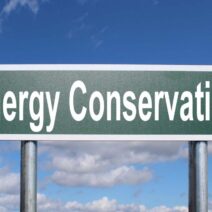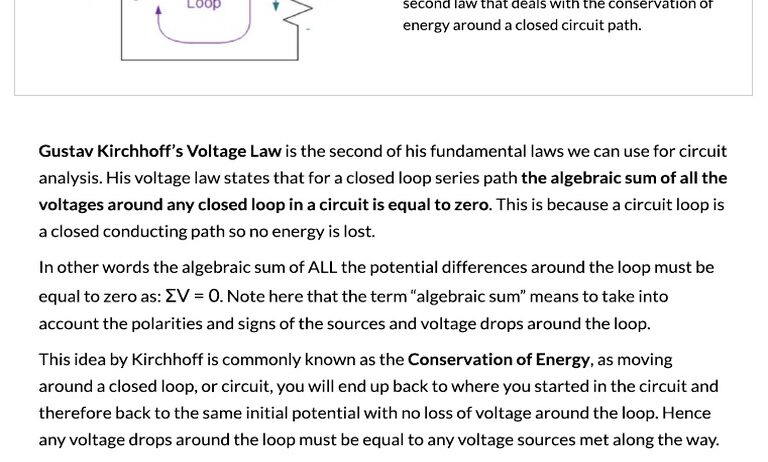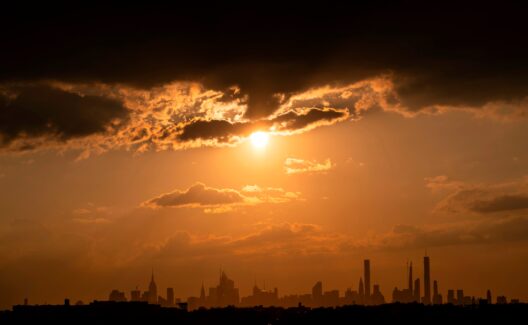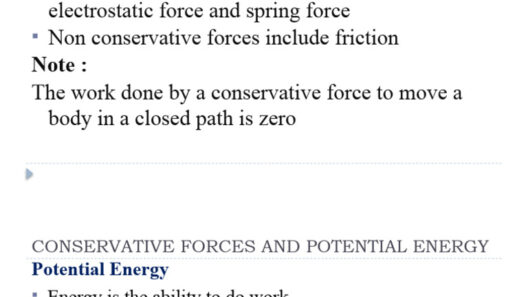When delving into the intricate realm of electrical circuits, one cannot help but ponder: Is Kirchhoff’s Rule rooted in the venerable principle of energy conservation? This query invites a delightful exploration of the fundamental laws governing electricity and their inherent connections to the broader laws of physics. Kirchhoff’s rules, particularly his current and voltage laws, elucidate how electrical currents and voltages function within a circuit, while the conservation of energy remains one of the most sacrosanct principles of physical science. But does Kirchhoff offer a tangible manifestation of this principle in action?
To embark upon this intellectual journey, let us first dissect Kirchhoff’s Voltage Law (KVL) and Kirchhoff’s Current Law (KCL). Kirchhoff’s Voltage Law stipulates that the sum of the electrical potential differences (voltage) around any closed loop in a circuit must equal zero. Imagine a water cycle where water travels through pipes, encountering pumps and narrowing pathways: at the end of the cycle, the energy gained by pumps is offset by the energy lost through friction and other factors. Conversely, Kirchhoff’s Current Law posits that the total current entering a junction must equal the total current exiting it. This can be likened to a bustling thoroughfare where vehicles converge at an intersection; the number of cars entering must equate with those departing, or else congestion ensues.
At the heart of these laws lies the presiding notion of energy balance. Kirchhoff’s laws, albeit derived from empirical observations, inexorably tie themselves to the conservation of energy. When one contemplates a closed circuit, energy is neither created nor destroyed; it merely transforms from one form to another—be it electrical energy converted to heat energy in a resistor or light energy in a bulb. This transformation adheres to the principle of conservation, rendering Kirchhoff’s laws essentially a mathematical representation of this physical theorem. Therefore, one may assert that Kirchhoff’s framework embodies energy conservation in the realm of electrical engineering.
However, a playful inquiry arises: if electrical energy can neither be created nor annihilated, does that imply an eternal cycle of energy within a closed circuit? Picture this: a hypothetical situation where a circuit is perpetually powered without a loss of energy. Such a condition would violate the laws of thermodynamics, indicating that perpetual motion machines—those that operate indefinitely without energy input—exist solely in the realm of fiction. This facet invites a critical examination of the assumptions underpinning Kirchhoff’s laws and highlights the limitations imposed by real-world conditions, such as resistance and energy dissipation.
A comprehensive understanding of Kirchhoff’s laws necessitates an exploration of their applicability within real circuits. In real-life scenarios, resistors dissipate energy as heat, causing losses that do not conform strictly to the mathematical applications of KVL and KCL. Such losses underscore the significance of energy conservation; although the laws maintain their predictive power for circuit behavior, practical deviations reveal the complexities inherent in physical systems. Hence, although Kirchhoff’s laws serve well for analysis and design, they operate under the constraints of ideal scenarios, which may not contain the full spectrum of energy transformations occurring within a circuit.
Delving deeper, the interplay between Kirchhoff’s rules and energy conservation finds expression through the framework of various circuit elements. Components such as capacitors and inductors provide further layers of complexity. Capacitors store energy electrostatically, while inductors store energy in a magnetic field. The energy within these devices, governed by Kirchhoff’s laws, must also adhere to conservation principles. Consequently, when assessing energy flow within these components and their impact on circuit dynamics, one recognizes that Kirchhoff’s laws are firmly embedded within the conservation of energy narrative.
Furthermore, a broader contemplation of the implications of Kirchhoff’s principles in the context of energy conservation cannot ignore contemporary issues, such as energy efficiency and sustainability. In a world increasingly focused on minimizing waste and maximizing energy utilization, understanding how Kirchhoff’s laws combine with energy conservation can empower engineers and designers to optimize circuit functionality and improve system efficiencies. For example, redesigning electrical systems to align them with rotating machinery or optimizing electronic devices can yield significant reductions in energy consumption, tightly linking Kirchhoff’s insights to the urgent demands of environmental stewardship.
As the dependency on renewable energy sources grows, the principles encapsulated in Kirchhoff’s laws become increasingly pertinent. The prospects of integrating solar panels, wind turbines, and various energy storage systems entail reconceptualizing circuit dynamics. Through the lens of energy conservation, one can glean insights into the optimal arrangements for maximizing energy transfer efficiency. Every circuit configuration must be scrutinized for adherence to the laws of Kirchhoff to ensure the sustainable usage of resources and the minimization of energy losses.
Indeed, the inquiry into whether Kirchhoff’s Rule is predicated on the conservation of energy reveals itself as both intriguing and substantial. As a synthesis of empirical observation and the unwavering principles of physics, Kirchhoff’s laws encapsulate energy conservation within the realm of electrical engineering. The playful query metamorphoses into an affirmation that, while Kirchhoff’s rules serve as a vital framework for understanding electrical circuits, they simultaneously reflect the broader narrative of energy conservation. The pursuit of efficient energy usage, rooted in the understanding of these foundational principles, is an endeavor that culminates in both technological advancement and environmental preservation.
In conclusion, the exploration of Kirchhoff’s laws as extensions of the conservation of energy unfolds a labyrinth of insights essential for modern society. This framework not only underpins our comprehension of circuits but also informs our approach to creating greener and more efficient technologies. In a world where energy discourse becomes increasingly salient, Kirchhoff’s suffusion of energy conservation beholds an enduring relevance.








